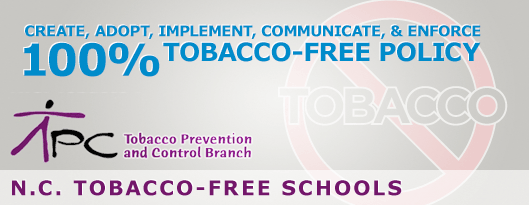Overall Strategies for Effective Policy Implementation
See also: Strategies for Enforcement
- Everyone's responsibility: North Carolina's schools are 100% tobacco-free for students, staff and visitors 24/7 on all school grounds, indoor and outdoor, and at school related events that are on or off-campus, including middle-college classes at the local community college, sporting events, and field trips. Everyone has a part in promoting a tobacco-free school campus: students, staff, principals, teachers, family members and others.
- School infrastructure: Identify a faculty member(s)/staff team to take the lead role in tobacco use prevention education, policy and cessation efforts for each school. Put tobacco use prevention in their job descriptions and provide the training and support necessary for them to do their job well.
- Staff support for students attempting to quit: Encourage teachers, coaches and other staff to allow students trying to quit tobacco or e-cigarettes to use techniques in class (deep breathing, water, texting program) to help them in their quitting process. Consider allowing students to use study hall, lunch or in-school suspension time to participate in telephone cessation counseling (1-800-QuitNow) or other cessation programs. The Truth Initiative has a text program called This is Quitting aimed at helping teens and young adults quit vaping. A student can text “DITCHJUUL” to 88709 to join.
- Student involvement: Involve all students in promoting a tobacco-free and vape-free lifestyle on campus. Involve students in the planning and implementation of positive health promotion activities that promote living tobacco-free, through student clubs and/or as peer educators. Create an environment that emphasizes that it is everyone's responsibility to promote a tobacco-free school environment. Resources for students and staff to learn more about tobacco prevention include:
- Curricula. CATCH My Breath™ is a new evidence-based tobacco use prevention curriculum that addresses middle and high schoolers' use of e-cigarettes. CATCH My Breath™ meets national and state educational standards. The curriculum is available free of charge to NC schools. More than 80 schools incorporated the curriculum during the 2018-19 school year.
- Proactive, clear and consistent communication: This is the most important for policy compliance. Tobacco-free school signs should be placed throughout the school's campus. Signs should be visible at campus entrances, building entrances, playing fields, bleachers, school vehicles, and other areas indicating the campus is a tobacco-free environment, including e-cigarettes (vapes). Announce the tobacco-free school policy, including e-cigarettes, at athletic events and other school events.
- Positive message: Emphasize the health, academic and social benefits of a tobacco-free school, with an emphasis on e-cigarettes, to staff, students, families and visitors. Encourage students to make responsible decisions about the health of their bodies, and to have respect for other students and staff by not using any tobacco products, including e-cigarettes, on campus or at school related events.
- Teaching tools for Parents, Coaches and Teachers. The Stanford Medicine Tobacco Use Prevention Toolkit is a new, theory-based and evidence-informed educational resource created by educators and researchers aimed at preventing middle and high school students' use of tobacco and nicotine products. The Tobacco Prevention Toolkit is committed to providing free tobacco/nicotine prevention materials to educators directly working with youth.


